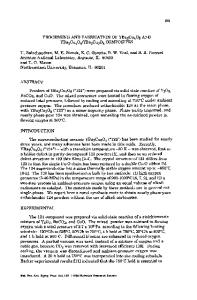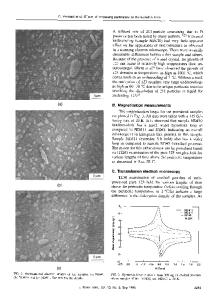Physical processing effects on polycrystalline YBa 2 Cu 3 O x
- PDF / 678,826 Bytes
- 7 Pages / 593.28 x 841.68 pts Page_size
- 101 Downloads / 312 Views
C.T. Chen, M. Hong, J. Kwo, and S.H. Liou AT& T Bell Laboratories, Murray Hill, New Jersey 07974 (Received 16 May 1988; accepted 13 September 1988) The effect of heating YBa2Cu3Ox in vacuum to 600 °C has been studied using photoelectron spectroscopy and diamagnetic susceptibility measurements. Evidence of two chemically distinct copper and barium species is found in single phase samples at room temperature cleaned by gentle heating at 450 °C. Such annealing also increases the volume diamagnetic susceptibility of the samples which suggests that the preferred stoichiometry of growth does not lead to an optimum superconducting phase. Samples cleaned by vacuum scraping or ion bombardment reveal more amorphous XPS structure and are less indicative of bulk properties.
I. INTRODUCTION In this report we present the results of a photoemission and diamagnetic susceptibility study of YBa 2Cu30^, x = 6.9, undertaken to examine the change of this material when heated in vacuum. Our aim was to understand more thoroughly the role of oxygen in fabricating the superconducting phase. It is believed that our results will also apply to other high Tc materials with a tripled perovskite structure. Heating our samples initially removes a surface phase consisting primarily of hydroxyl species and serves to anneal the as-prepared samples. For example, the volume contributing to the superconducting phase is increased by heating as measured by magnetization. Examining the annealed samples, we also infer the presence of two, chemically distinct barium atoms in the defect crystal associated with disordered chains of defect sites. Extensive heating, although at a relatively low temperature of 600 °C, results in the complete loss of the superconducting phase. However, it is demonstrated that such samples can be regenerated by calcining in the usual manner. II. EXPERIMENTAL The preparation of the YBa 2 Cu 3 0 x material from Y2O3, BaCO3, and CuO powders was performed at AT&T Bell Laboratories in a manner described previously.1 Subsequent characterization of the as-prepared samples indicated1 (i) the ac and dc resistance superconducting transition temperature was 91 K; (ii) the structure of the superconducting phase determined by both x-ray and electron diffraction was orthorhombic; (iii) the polycrystalline samples consisted of a single phase. The photoemission experiments were performed in an experimental chamber equipped with a Leybold-Hereaus EA-11 ESCA analyzer, a Leybold-Hereaus dual anode x-ray source, and a helium gas ultraviolet lamp. The electron analyzer lens system had a spot size of 3 mm, smaller than the sample surface extent. The Al(Ka) anode with photon 16
http://journals.cambridge.org
J. Mater. Res., Vol. 4, No. 1, Jan/Feb 1989
Downloaded: 18 Mar 2015
energy of 1486.6 eV and a 50 eV analyzer pass energy yielding an electron energy resolution of 0.4 eV were used for the XPS studies. Two sample holders were employed: a low temperature probe onto which the samples were pasted into place using silver paint was used for the UPS st
Data Loading...











